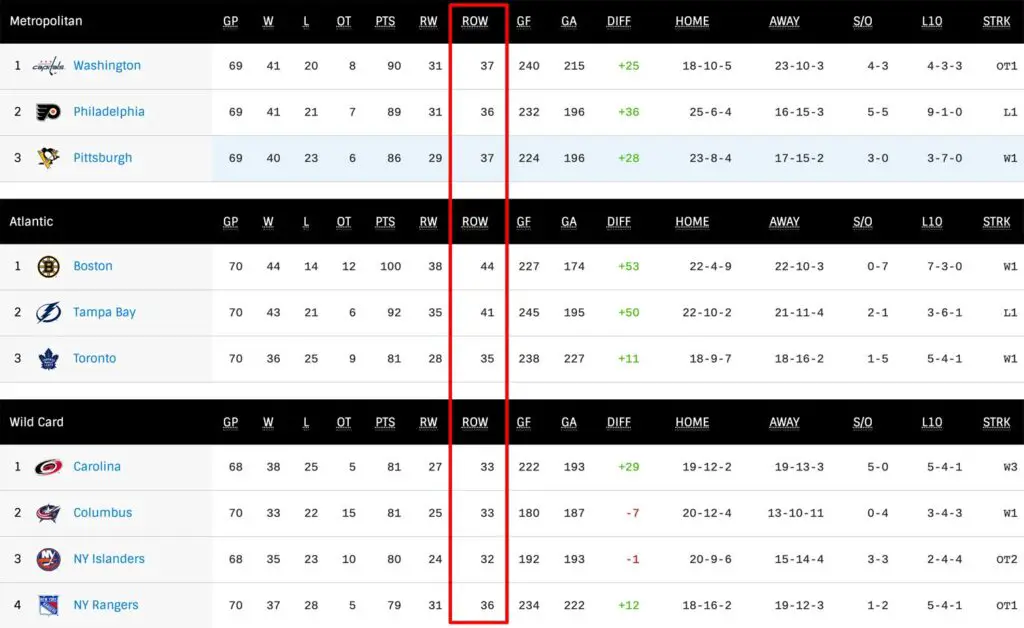Discover the true essence of “Hockey ROW Meaning” – delve into the significance of Regulation and Overtime Wins in hockey standings, unraveling its impact on team performance and playoff positioning.
Introduction
Hockey ROW(Regulation and Overtime Wins) Meaning lies at the core of understanding team performance in the sport. As teams strive for victory on the ice, the concept of ROW plays a pivotal role in assessing their success. Let’s embark on a journey to unravel the significance of ROW, its calculation, and its implications for teams in hockey standings.
Regulation and Overtime Wins in Hockey
Definition:
Regulation and Overtime Wins, often abbreviated as ROW, refer to the number of games a hockey team has won during regulation time or overtime, excluding shootout victories. In essence, these wins encompass all triumphs achieved within the standard gameplay duration of three periods (60 minutes) and any additional overtime periods.
Regulation Wins:
A regulation win occurs when a team emerges victorious within the standard 60-minute playing time, including three periods of regulation play. These wins are the epitome of a team’s prowess and dominance on the ice, showcasing their ability to outplay their opponent within the allotted time frame. Regulation wins are considered the most coveted victories, as they exemplify a team’s skill, strategy, and overall performance without the need for additional overtime or shootout periods.
Overtime Wins:
Overtime wins, on the other hand, occur when a game extends beyond the standard regulation time into one or more additional periods to break a tie. In professional hockey leagues, such as the NHL, overtime periods typically consist of five-minute sudden-death periods, where the first team to score wins the game. Overtime wins are crucial for teams as they demonstrate resilience, determination, and the ability to perform under pressure during critical moments of the game.
Understanding the significance of ROW is essential for several reasons:
- Differentiation: ROW serves as a vital statistic for distinguishing between teams based on their ability to secure victories outright, rather than relying on shootout outcomes. It provides a clearer picture of a team’s actual winning capabilities during regular and extended gameplay.
- Tiebreaker in Standings: In hockey standings, ROW plays a pivotal role in breaking ties between teams with the same number of points. In leagues like the NHL, where playoff seeding is determined by points, ROW serves as the primary tiebreaker. Teams with a higher ROW value are ranked higher in the standings, emphasizing the importance of winning games within regulation and overtime.
- Playoff Implications: As teams vie for playoff berths and positioning, ROW can significantly impact playoff scenarios. In the NHL, tiebreakers based on ROW can ultimately determine which teams qualify for the playoffs and their seeding, influencing their postseason journey.
Why is ROW an Important Statistic in Hockey Standings?
- Accurate Representation of Winning Ability: ROW provides a more accurate representation of a team’s winning ability by focusing on victories achieved during regulation play or overtime, excluding shootout wins. This metric highlights a team’s capacity to secure wins outright, reflecting their proficiency and dominance on the ice.
- Clear Differentiation between Teams: In leagues where teams accumulate points for wins and ties, ROW serves as a critical differentiator. It helps distinguish between teams with the same number of points by showcasing their success in winning games within standard and extended gameplay durations. Teams with a higher ROW value are often ranked higher in the standings, providing a clearer picture of their overall performance.
- Emphasis on Regulation and Overtime Performance: By placing importance on wins achieved during regulation and overtime, ROW encourages teams to focus on gameplay strategies that lead to decisive victories within the standard playtime. This emphasis fosters a competitive environment where teams strive to excel during crucial moments of the game, ultimately enhancing the quality of play.
How Does ROW Affect Tiebreakers in the NHL?
In the NHL, tiebreakers are crucial for determining playoff seeding and standings, especially when teams have the same number of points. ROW plays a significant role in NHL tiebreakers, influencing the following scenarios:
- Primary Tiebreaker: When two or more teams have the same number of points, the primary tiebreaker in the NHL is the ROW statistic. Teams with a higher number of regulation and overtime wins are ranked higher in the standings, providing them with a competitive advantage in playoff seeding and positioning.
- Impact on Playoff Qualification: ROW can ultimately determine which teams qualify for the playoffs, especially in tight races where multiple teams are competing for postseason berths. Teams with a higher ROW value are more likely to secure playoff spots, highlighting the importance of winning games within regulation and overtime.
- Determining Playoff Matchups: In addition to playoff seeding, ROW also influences playoff matchups by determining which teams face each other in the postseason. Higher-seeded teams with a superior ROW value often face lower-seeded teams with fewer ROWs, shaping the dynamics of playoff series and matchups.

Can a Shootout Win Affect a Team’s ROW Value?
No, a shootout win does not affect a team’s ROW value. In hockey standings, ROW specifically refers to victories secured during regulation play or overtime, excluding shootout outcomes. While shootout wins contribute to a team’s overall point total, they are not factored into the calculation of ROW. This distinction is crucial as it ensures that ROW accurately reflects a team’s ability to win games within the standard and extended gameplay durations, without the influence of shootout scenarios.
Shootouts serve as tie-breaking procedures to determine the winner of a game when it remains tied after regulation play and overtime. Although shootout wins contribute to a team’s overall success, they are considered separately from ROW to maintain the integrity of the statistics and provide a more focused assessment of a team’s performance during standard gameplay situations.
How is ROW Calculated?
ROW calculation involves a straightforward process based on the total number of wins a team has accumulated during regulation play and overtime. Here’s a step-by-step guide to understanding ROW calculation:
- Total Regulation Wins: Begin by tallying the number of games a team has won during the standard 60-minute regulation playtime. These wins are achieved without the need for overtime or shootout scenarios.
- Overtime Wins: Additionally, include any victories secured by the team during overtime periods. Overtime wins contribute to the team’s ROW value as they demonstrate the team’s ability to perform under pressure and secure victories beyond regulation play.
- Exclude Shootout Wins: It’s essential to exclude shootout wins from the calculation of ROW. Shootout wins do not count towards a team’s ROW value, as they represent a separate category of victories determined by tie-breaking procedures rather than gameplay within regulation or overtime periods.
- Calculate ROW: Once the total number of regulation and overtime wins is determined, this figure represents the team’s ROW value. ROW serves as a valuable statistic for assessing a team’s success in winning games outright, without the need for shootout outcomes.
Can a Team with a Higher ROW Value Still Have Fewer Total Points Than Another Team?
Yes, a team with a higher ROW value can have fewer total points than another team. This scenario arises due to the influence of overtime losses and shootout outcomes on a team’s total point accumulation. Here’s how it works:
- Overtime Losses: While ROW specifically focuses on wins achieved during regulation play and overtime, it does not account for losses incurred during overtime periods. Teams may earn a single point for losing in overtime, contributing to their total points tally but not affecting their ROW value.
- Shootout Outcomes: Similarly, shootout wins and losses contribute to a team’s total points but are excluded from the calculation of ROW. Teams earn two points for a shootout win and one point for a shootout loss, regardless of their performance during regulation and overtime play.
As a result, a team with a higher ROW value may still have fewer total points than another team if the latter has accumulated more points from overtime losses and shootout outcomes. This discrepancy highlights the importance of considering both ROW and total points when assessing a team’s overall performance and standings within the league.

Does ROW Affect the Way Teams Play During Regulation Time or Overtime?
While ROW itself does not directly dictate how teams play during regulation time or overtime, it can indirectly influence their gameplay strategies and approach to critical moments of the game. Here’s how ROW may impact team dynamics:
- Emphasis on Regulation and Overtime Victories: The importance of ROW in determining standings and playoff seeding incentivizes teams to prioritize winning games outright during regulation play and overtime. Teams may adopt more aggressive tactics and strategies aimed at securing decisive victories rather than relying on shootout outcomes.
- Strategic Decision-Making: Coaches and players may adjust their tactics and lineup decisions based on the significance of ROW in the standings. In critical situations, teams may prioritize offensive opportunities and defensive strategies that maximize their chances of securing regulation and overtime wins.
- Resilience and Determination: The emphasis on ROW underscores the importance of resilience and determination during crucial moments of the game. Teams may exhibit a heightened sense of urgency and intensity during regulation time and overtime, knowing that each victory contributes directly to their ROW value and overall success in the league.
FAQs On Hockey ROW Meaning
Can shootout wins impact a team’s ROW value?
No, shootout wins do not affect a team’s ROW value, as ROW specifically focuses on wins achieved during regulation play and overtime.
How is ROW calculated?
ROW is calculated by tallying the total number of wins a team has achieved during regulation play and overtime, excluding shootout outcomes.
Can a team with a higher ROW value have fewer total points than another team?
Yes, a team with a higher ROW value can have fewer total points than another team, depending on their performance in overtime and shootout scenarios.
Does ROW influence the way teams play during regulation time or overtime?
While ROW itself does not directly affect team gameplay, it may indirectly influence team strategies and decision-making during critical moments of the game.
What role does ROW play in playoff scenarios?
ROW directly impacts playoff positioning and seeding, serving as a crucial factor in determining a team’s postseason journey and prospects.
How does ROW contribute to analyzing team performance?
ROW provides valuable insights into a team’s competitiveness and success on the ice, allowing analysts and fans to assess their strengths and weaknesses in standard gameplay situations.
Conclusion
The Role of ROW in Evaluating Team Performance In conclusion, Hockey ROW(Regulation and Overtime Wins) Meaning plays a pivotal role in evaluating team performance and determining standings within the league. By emphasizing victories achieved during regulation play and overtime, ROW offers a comprehensive assessment of a team’s success on the ice. As teams strive for excellence, ROW serves as a guiding beacon, shaping their path toward success in the dynamic landscape of hockey.
